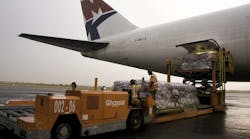The aircraft ground handling industry in Australia is very dynamic and Swissport’s acquisition of Aerocare is one of the most noteworthy recent events.
When asked about consolidation in the industry, Glenn Rutherford, senior vice president Pacific at Swissport said the trend is caused by several factors.
“In terms of the drivers, the quality and complexity of safety and compliance systems required can be difficult or even impossible to sustain commercially at a small scale. With increased fuel prices and other pressures, carriers are continuously seeking cost and quality advantages which can generally be better achieved through consolidation,” he says.
The consolidation of the aircraft ground handling industry in Australia is happening at a time when Australasian airports have developed master plans that include aircraft ground handling infrastructure development.
“Australian airports generally have master plans in line with forecasts for airline and passenger growth, of which ground handling infrastructure is a key component. While master plans establish the strategic direction for the individual airports, there is usually a focus on ensuring infrastructure investment will support growth and passenger experience and other objectives such as carbon emission reduction,” says Rutherford. “For example, at Brisbane Airport, construction has been underway on a facility for maintenance and charging of the airport’s fleet of 11 electric buses which are managed by Swissport.
“Airports in Australia are increasingly investing in terminal technology, including common user check-in kiosks, smart gates, automated bag drop machines, biometrics trials and common-user charging for electric vehicles.”
Aircraft ground handling in Australia has its own specific enablers and constraints.
“Within dnata’s Australian network, the key constraint that needs to be managed is the differences and variability of airport infrastructure. These constraints are varied across the different airports but the key constraint is space, both from a facilities perspective and ramp infrastructure,” says Brett Fuller, head of ground services at dnata’s Australian operations.
The Australian domestic market is dominated by two key groups, Qantas and Virgin Australia, and the barriers to entry for other carriers are significant.
Rutherford explains that Australia’s Civil Aviation Safety Authority (CASA) regulates airlines (rather than the ground handling industry) and each airline has its own way of operating for each aircraft, which requires individual processes.
“Swissport is collaborating with carriers to standardize functions which do not enhance or differentiate the carrier’s product or brand, for example functions such as door opening and vehicle operation,” says Rutherford. “The output of this is increased safety as staff will learn a single way to perform tasks, and increased efficiency as training will be done once, one way instead of multiple times, different ways. Requirements also differ between CASA and the Civil Aviation Authority of New Zealand (CAANZ).”
Australia also has distinctive training and education requirements.
“Broader training required in the region relates to topics such as dangerous goods, anti-discrimination, information privacy, disability awareness and Drug and Alcohol Management Plan (DAMP) Policy Awareness,” notes Rutherford.
The growing aircraft ground handling industry is also characterized by the fact that additional ground support equipment (GSE) is being purchased and, in general, GSE fleets are being renewed with equipment that offer the latest technology features.
“In Australia, Swissport is investing in new equipment to support new contract wins, along with fleet replacement to upgrade and modernize equipment,” says Rutherford. “We have a strong maintenance program in place and regularly remove aged assets in favor of a newer fleet with improved efficiency and safety features. Swissport’s is possibly the youngest and most optimized fleet in Australia.”
Globally Swissport is investing in collision avoidance systems and telematics options to maximize safety outcomes and improve efficiency and utilization. Swissport’s fleet strategy is also to use battery powered equipment wherever possible, ranging from smaller units like baggage tractors through to heavy units like pushback tractors and airport passenger buses.
“When Swissport commenced handling for Virgin Australia’s entire New Zealand network in late 2017, more than half of the GSE procured was electric, including 13 baggage units. We also procured a 100 percent electric towbarless aircraft pushback tractor, which we believe was the first of its kind in Australia,” says Rutherford. “Globally, in 2017 Swissport doubled the amount of eGSE purchased compared with 2016 and we are on track to achieve this again in 2018. Swissport has Australia’s largest fleet of electric buses, which has made a significant contribution to reducing carbon emissions at some of the country’s largest airports.”
Over the past nine months, dnata has been undertaking a fleet renewal program of its motorized GSE fleet in Australia in partnership with Adaptalift Group.
“Via a sale-and-leased-back commercial arrangement dnata and Adaptalift are in the process of replacing and introducing 135 new GSE ranging from baggage tugs and motorized conveyor belts to aircraft loaders and pushback tractors. In addition, further GSE will be refurbished to bring the average fleet age of GSE in dnata’s Australian network down from 12 to 4.5 years,” dnata’s Fuller points out.
“A key part of the replacement program is the introduction of telematics to all new equipment as well as retrofitting the existing fleet,” he continues. “Adaptalift’s in-house telematics, ‘speed-shield,’ combined with the introduction of proximity sensors of all new loaders will both enhance dnata’s ability to better manage the fleet as well as dramatically improve safety for our people.”








